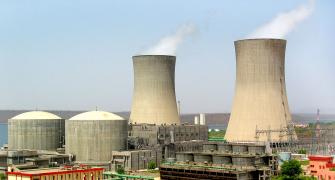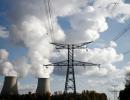The major advantages of such plants are no need of land to build the reactors, earthquake resistant, abundance of water for active or passive cooling.

Nuclear powered submarines, icebreakers are old for Russia's integrated nuclear power major Rosatom State Atomic Energy Corporation (Rosatom).
The current focus for Rosatom is selling the low power floating or land based nuclear power plants globally including India with the world's first floating nuclear power unit Akademik Lomonosov functioning in Russia's Arctic port town Pevek as the reference site.
'Our floating nuclear power plant will be the reference site for Rosatom to sell similar units to interested countries,' said Viktor Nikolayevich Chyorny, deputy chief engineer for engineering support and quality, Rosatom.
Recently Rosatom was successful in clinching a contract from Uzbekistan for construction of the 330 MW Russian-design low-power nuclear power plant (NPP -- six reactors of 55 MW each).
According to Rosatom, the low-power NPP project in Uzbekistan is based on the latest Russian development -- the RITM-200N water-water nuclear reactor, which is the result of adapting the RITM-200 edge-cutting low-power ship-based technology to land-based deployment.
The compactness, integral layout and reduced construction rates are principal features of the design as compared to high-power nuclear power plants.
The world's first floating nuclear power plant Akademik Lomonosov -- named after the 18th century Russian scientist Mikhail Lomonosov -- is 144 metres long, 30 metres wide with a displacement of about 21,000 tons is docked on the shores of the icy waters of the East Siberian Sea to power the coastal town Pevek.
The vessel houses two small light water reactors each with a generation capacity of 35MW similar to the ones powering Russia's icebreaker vessels.
Senior Rosatom officialssaid the company is building four more floating nuclear power plants each with about 50 MW capacity and will be stationed in various places.
For starters, a floating nuclear power plant is a ship based plant that can be connected and disconnected to the power transmission lines of a coastal town and towed away from location to location.
Rosatom officials said the life of such plants is about 40 years and can be extended further by taking necessary actions.
Rosatom Director General Alexey Likhachev said the company is keen to expand cooperation with India including implementing floating and land based nuclear power units apart from serial construction of high powered plants.
The major advantages of such plants are no need of land to build the reactors, earthquake resistant, abundance of water for active or passive cooling.
The vessel can be towed away and decommissioned at an appropriate place.
Rosatom officials said about 200 persons - split equally between onboard and off shore -- manage the operations at Akademik Lomonosov.
The small uranium based floating nuclear power plant has been generating power and heat without any incidents since 2019, lighting up homes and other establishments in Pevek and keeping the residents warm.
However, the floating nuclear power plant is currently functioning at a much lower capacity owing to the existence of an old and functioning 30 MW thermal power plant.
Deputy Chief Engineer Viktor Chyorny said the demand for power is low for the reactors to be run on full capacity as the thermal plant is also working.
With plans to shut down the thermal power plant at Pevek and decommissioning three more 12 MW nuclear power reactors at Bilibino in the Chukotka region in couple of year's time, power generation at the floating nuclear plant will be increased to its full capacity to power Pevek, he added.
According to Chyorny, the two reactors on the Akademik Lomonosov function independently so that power and heat supply can be maintained uninterrupted when one of the reactors is under maintenance or goes for refuelling once in five years.
Last year one reactor was fully refueled and the second reactor will undergo refueling this year. During the refueling the entire fuel bundle will be replaced with a fresh one.
For Russia, small and mobile nuclear power plants are not new. During the 1960s in its earlier USSR avatar a land based 1.5 MW small mobile reactor was built.
The mobile atomic power plant consisted of wagon type four mobile platforms housing the reactor, turbine, auxiliary and control units.
The reactor and other equipment were mounted on elongated tracked chassis of a heavy tank. Later the plant was decommissioned.
The small town Pevek was set up in the 1930s with the economy mainly powered by the mining sector and its workforce.
At its peak, Pevek had a total population of about 15,000 people and the region about 30,000 people.
During World War II, tin was mined in large quantities. Later gold was also mined in the region, Rosatom officials said.
But the break of the USSR in 1991 saw the mines shutting down operations and people leaving Pevek.
Currently there are about 5,000 people and the Russian government is reviving the town with fresh projects like the floating nuclear power plant and others.
Venkatachari Jagannathan can be reached at venkatacharijagannathan@gmail.com
Feature Presentation: Aslam Hunani/Rediff.com










